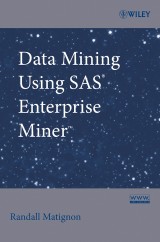Details

Data Mining Using SAS Enterprise Miner
Wiley Series in Computational Statistics, Band 638 1. Aufl.
|
117,99 € |
|
| Verlag: | Wiley |
| Format: | |
| Veröffentl.: | 13.08.2007 |
| ISBN/EAN: | 9780470171424 |
| Sprache: | englisch |
| Anzahl Seiten: | 584 |
DRM-geschütztes eBook, Sie benötigen z.B. Adobe Digital Editions und eine Adobe ID zum Lesen.
Beschreibungen
<p><b>The most thorough and up-to-date introduction to data mining techniques using SAS Enterprise Miner.</b></p> <p>The Sample, Explore, Modify, Model, and Assess (SEMMA) methodology of SAS Enterprise Miner is an extremely valuable analytical tool for making critical business and marketing decisions. Until now, there has been no single, authoritative book that explores every node relationship and pattern that is a part of the Enterprise Miner software with regard to SEMMA design and data mining analysis.</p> <p>Data Mining Using SAS Enterprise Miner introduces readers to a wide variety of data mining techniques and explains the purpose of-and reasoning behind-every node that is a part of the Enterprise Miner software. Each chapter begins with a short introduction to the assortment of statistics that is generated from the various nodes in SAS Enterprise Miner v4.3, followed by detailed explanations of configuration settings that are located within each node. Features of the book include:</p> <ul> <li>The exploration of node relationships and patterns using data from an assortment of computations, charts, and graphs commonly used in SAS procedures</li> <li>A step-by-step approach to each node discussion, along with an assortment of illustrations that acquaint the reader with the SAS Enterprise Miner working environment</li> <li>Descriptive detail of the powerful Score node and associated SAS code, which showcases the important of managing, editing, executing, and creating custom-designed Score code for the benefit of fair and comprehensive business decision-making</li> <li>Complete coverage of the wide variety of statistical techniques that can be performed using the SEMMA nodes</li> <li>An accompanying Web site that provides downloadable Score code, training code, and data sets for further implementation, manipulation, and interpretation as well as SAS/IML software programming code</li> </ul> <p>This book is a well-crafted study guide on the various methods employed to randomly sample, partition, graph, transform, filter, impute, replace, cluster, and process data as well as interactively group and iteratively process data while performing a wide variety of modeling techniques within the process flow of the SAS Enterprise Miner software. Data Mining Using SAS Enterprise Miner is suitable as a supplemental text for advanced undergraduate and graduate students of statistics and computer science and is also an invaluable, all-encompassing guide to data mining for novice statisticians and experts alike.</p>
<p>Introduction</p> <p><b>Chapter 1: Sample Nodes 1</b></p> <p>1.1 Input Data Source Node 3</p> <p>1.2 Sampling Node 32</p> <p>1.3 Data Partition Node 45</p> <p><b>Chapter 2: Explore Nodes 55</b></p> <p>2.1 Distribution Explorer Node 57</p> <p>2.2 Multiplot Node 64</p> <p>2.3 Insight Node 74</p> <p>2.4 Association Node 75</p> <p>2.5 Variable Selection Node 99</p> <p>2.6 Link Analysis Node 120</p> <p><b>Chapter 3: Modify Nodes 153</b></p> <p>3.1 Data Set Attributes Node 155</p> <p>3.2 Transform Variables Node 160</p> <p>3.3 Filter Outliers Node 169</p> <p>3.4 Replacement Node 178</p> <p>3.5 Clustering Node 192</p> <p>3.6 SOMiKohonen Node 227</p> <p>3.7 Time Series Node 248</p> <p>3.8 Interactive Grouping Node 261</p> <p><b>Chapter 4: Model Nodes 277</b></p> <p>4.1 Regression Node 279</p> <p>4.2 Model Manager 320</p> <p>4.3 Tree Node 324</p> <p>4.4 Neural Network Node 355</p> <p>4.5 PrincompiDmneural Node 420</p> <p>4.6 User Defined Node 443</p> <p>4.7 Ensemble Node 450</p> <p>4.8 Memory-Based Reasoning Node 460</p> <p>4.9 Two Stage Node 474</p> <p><b>Chapter 5: Assess Nodes 489</b></p> <p>5.1 Assessment Node 491</p> <p>5.2 Reporter Node 511</p> <p><b>Chapter 6: Scoring Nodes 515</b></p> <p>6.1 Score Node 517</p> <p><b>Chapter 7: Utility Nodes 525</b></p> <p>7.1 Group Processing Node 527</p> <p>7.2 Data Mining Database Node 537</p> <p>7.3 SAS Code Node 541</p> <p>7.4 Control point Node 552</p> <p>7.5 Subdiagram Node 553</p> <p>References 557</p> <p>Index 560</p>
<p>"The book provides a good account of the numerical and computational approaches used within the various nodes and explains necessary background concepts." (<i>The American Statistician,</i> May 2009)</p> <p>"... a very detailed user guide." (<i>MAA Reviews,</i> December 26, 2007)</p>
<b>Randall Matignon, MS</b>, is Senior Clinical SAS / Microsoft Office VBA Programmer for Amgen, Inc. in San Francisco, California. He has over twenty years of experience as a statistical programmer and applications developer in the pharmaceutical, healthcare, and biotechnology industries, and he has a broad knowledge of several programming languages, including SAS, S-Plus, and PL-SQL.
Diese Produkte könnten Sie auch interessieren:

Nonparametric Regression Methods for Longitudinal Data Analysis

von: Hulin Wu, Jin-Ting Zhang

135,99 €

Statistics and the Evaluation of Evidence for Forensic Scientists

von: Colin Aitken, Franco Taroni

103,99 €














